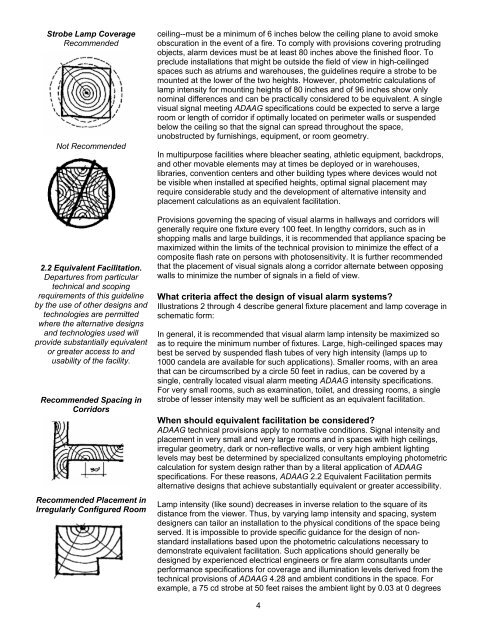Fire Protection Design Manual - Office of Construction and Facilities ...
Fire Protection Design Manual - Office of Construction and Facilities ...
Fire Protection Design Manual - Office of Construction and Facilities ...
You also want an ePaper? Increase the reach of your titles
YUMPU automatically turns print PDFs into web optimized ePapers that Google loves.
Strobe Lamp Coverage<br />
Recommended<br />
Not Recommended<br />
2.2 Equivalent Facilitation.<br />
Departures from particular<br />
technical <strong>and</strong> scoping<br />
requirements <strong>of</strong> this guideline<br />
by the use <strong>of</strong> other designs <strong>and</strong><br />
technologies are permitted<br />
where the alternative designs<br />
<strong>and</strong> technologies used will<br />
provide substantially equivalent<br />
or greater access to <strong>and</strong><br />
usability <strong>of</strong> the facility.<br />
Recommended Spacing in<br />
Corridors<br />
Recommended Placement in<br />
Irregularly Configured Room<br />
ceiling--must be a minimum <strong>of</strong> 6 inches below the ceiling plane to avoid smoke<br />
obscuration in the event <strong>of</strong> a fire. To comply with provisions covering protruding<br />
objects, alarm devices must be at least 80 inches above the finished floor. To<br />
preclude installations that might be outside the field <strong>of</strong> view in high-ceilinged<br />
spaces such as atriums <strong>and</strong> warehouses, the guidelines require a strobe to be<br />
mounted at the lower <strong>of</strong> the two heights. However, photometric calculations <strong>of</strong><br />
lamp intensity for mounting heights <strong>of</strong> 80 inches <strong>and</strong> <strong>of</strong> 96 inches show only<br />
nominal differences <strong>and</strong> can be practically considered to be equivalent. A single<br />
visual signal meeting ADAAG specifications could be expected to serve a large<br />
room or length <strong>of</strong> corridor if optimally located on perimeter walls or suspended<br />
below the ceiling so that the signal can spread throughout the space,<br />
unobstructed by furnishings, equipment, or room geometry.<br />
In multipurpose facilities where bleacher seating, athletic equipment, backdrops,<br />
<strong>and</strong> other movable elements may at times be deployed or in warehouses,<br />
libraries, convention centers <strong>and</strong> other building types where devices would not<br />
be visible when installed at specified heights, optimal signal placement may<br />
require considerable study <strong>and</strong> the development <strong>of</strong> alternative intensity <strong>and</strong><br />
placement calculations as an equivalent facilitation.<br />
Provisions governing the spacing <strong>of</strong> visual alarms in hallways <strong>and</strong> corridors will<br />
generally require one fixture every 100 feet. In lengthy corridors, such as in<br />
shopping malls <strong>and</strong> large buildings, it is recommended that appliance spacing be<br />
maximized within the limits <strong>of</strong> the technical provision to minimize the effect <strong>of</strong> a<br />
composite flash rate on persons with photosensitivity. It is further recommended<br />
that the placement <strong>of</strong> visual signals along a corridor alternate between opposing<br />
walls to minimize the number <strong>of</strong> signals in a field <strong>of</strong> view.<br />
What criteria affect the design <strong>of</strong> visual alarm systems?<br />
Illustrations 2 through 4 describe general fixture placement <strong>and</strong> lamp coverage in<br />
schematic form:<br />
In general, it is recommended that visual alarm lamp intensity be maximized so<br />
as to require the minimum number <strong>of</strong> fixtures. Large, high-ceilinged spaces may<br />
best be served by suspended flash tubes <strong>of</strong> very high intensity (lamps up to<br />
1000 c<strong>and</strong>ela are available for such applications). Smaller rooms, with an area<br />
that can be circumscribed by a circle 50 feet in radius, can be covered by a<br />
single, centrally located visual alarm meeting ADAAG intensity specifications.<br />
For very small rooms, such as examination, toilet, <strong>and</strong> dressing rooms, a single<br />
strobe <strong>of</strong> lesser intensity may well be sufficient as an equivalent facilitation.<br />
When should equivalent facilitation be considered?<br />
ADAAG technical provisions apply to normative conditions. Signal intensity <strong>and</strong><br />
placement in very small <strong>and</strong> very large rooms <strong>and</strong> in spaces with high ceilings,<br />
irregular geometry, dark or non-reflective walls, or very high ambient lighting<br />
levels may best be determined by specialized consultants employing photometric<br />
calculation for system design rather than by a literal application <strong>of</strong> ADAAG<br />
specifications. For these reasons, ADAAG 2.2 Equivalent Facilitation permits<br />
alternative designs that achieve substantially equivalent or greater accessibility.<br />
Lamp intensity (like sound) decreases in inverse relation to the square <strong>of</strong> its<br />
distance from the viewer. Thus, by varying lamp intensity <strong>and</strong> spacing, system<br />
designers can tailor an installation to the physical conditions <strong>of</strong> the space being<br />
served. It is impossible to provide specific guidance for the design <strong>of</strong> nonst<strong>and</strong>ard<br />
installations based upon the photometric calculations necessary to<br />
demonstrate equivalent facilitation. Such applications should generally be<br />
designed by experienced electrical engineers or fire alarm consultants under<br />
performance specifications for coverage <strong>and</strong> illumination levels derived from the<br />
technical provisions <strong>of</strong> ADAAG 4.28 <strong>and</strong> ambient conditions in the space. For<br />
example, a 75 cd strobe at 50 feet raises the ambient light by 0.03 at 0 degrees<br />
4

















